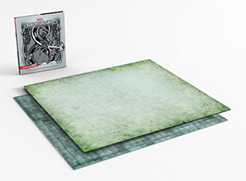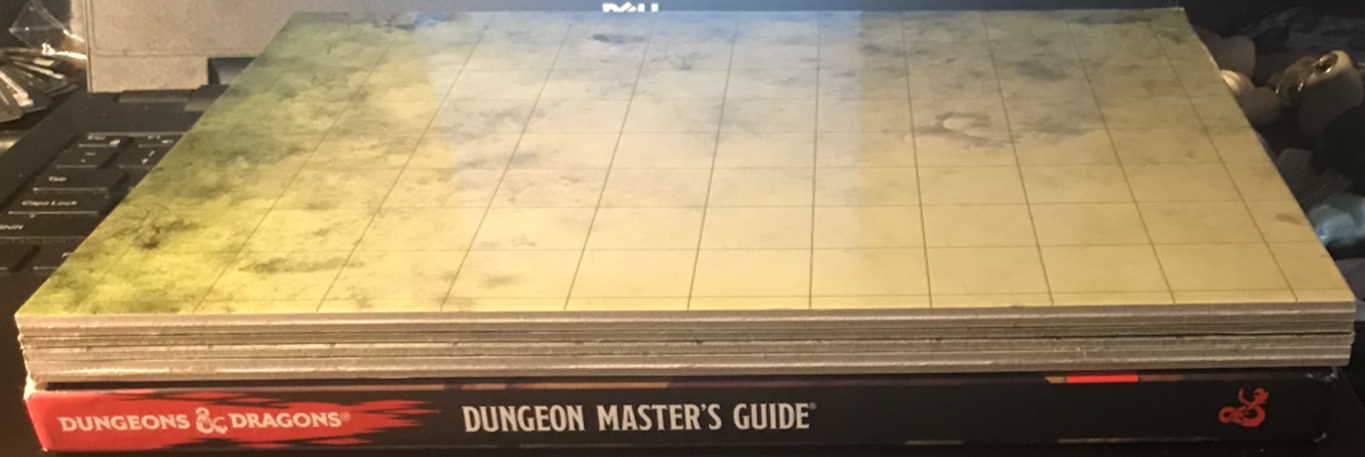 One of the more popular RPG accessory over the past few years has been the Flip-Mat, a double-sided thin cardboard mat that is pre-printed with a one-inch grid and an aesthetically pleasing (with luck!) background. They are designed so that you can use dry or wet erase markers on them, which then can be erased. With the rise in prominence of miniatures play since the release of the original D&D Miniatures line in 2003, the Flip-Mat has turned into an essential part of many DMs’ toolboxes.
One of the more popular RPG accessory over the past few years has been the Flip-Mat, a double-sided thin cardboard mat that is pre-printed with a one-inch grid and an aesthetically pleasing (with luck!) background. They are designed so that you can use dry or wet erase markers on them, which then can be erased. With the rise in prominence of miniatures play since the release of the original D&D Miniatures line in 2003, the Flip-Mat has turned into an essential part of many DMs’ toolboxes.
There was just one problem: They had a Pathfinder branding. This does make a difference, even if the actual grid is generic. The new D&D branding will do a lot to reassure customers (and stores) that the mat can be used with Dungeons & Dragons games. (This is surprisingly important).
With the D&D Adventure Grid we finally get a Dungeons & Dragons-branded grid. However, Wizards weren’t content to just copy the Flip-Mat design. Instead, they put the grid on a thick board reminisicent of many boardgame boards I’ve used (and superior to not a few). Folded up, it’s about the same size as a Player’s Handbook (of course, I used the DMG in the photos I took), and it unfolds to provide a 25 inch by 21 inch playing surface. One side of the grid displays a grassy wilderness, the other a dungeon floor.

The dimensions of the D&D Adventure Grid are not as big as the Flip-Mats. 25 by 21 squares is less than the 30 by 24 squares of the Flip-Mat. The D&D Adventure Grid has a number of slivers of squares, so it’s a little bigger than 25 by 21 inches.
The added quality and thickness of the board comes at a cost; at a recommended price of US$24.95, it’s a moderately expensive product. The corresponding Flip-Mat is US$14.99.

As my copy is brand new, I’ve yet to determine if it suffers from warping (something a few game boards have suffered over the years). I certainly hope not, but we’ll see. It feels nice to the hand; the finish is smooth and slightly slippery, not doubt a requirement to get the erasable markers to work on it.
I’m going to put it through its paces at PAX Australia next weekend. If anything goes drastically wrong with it, I’ll let you know!
However, my initial impressions are favourable. It’s interesting what a difference having it on board makes; it feels more substantial and more real than the Flip-Mats!

PAX is certainly a rigorous field test!
Interesting that they used a heavy cardboard… but how is it that the branding is “surprisingly important”? Do you really think that people unknowingly pass up the purchase of an accessory like this just because it doesn’t say “D&D”?
Yeah, I think that players new to the game would pass over “Pathfinder” branded gear and ask where the “D&D” gear is instead. Though I would hope that a DM would know better, even a new DM, and that a player would be directed (by retail staff) towards another hardcover, an unpainted mini, or even the new character sheet folder instead. I mean, I was playing all sorts of RPGs from about 1985-1994, came back in with the launch of 5e, and the only opinion I have about Pathfinder is to stay the hell away from anything to do with it.
“The new D&D branding will do a lot to reassure customers (and stores) that the mat can be used with Dungeons & Dragons games”. I hate to sound like a jerk, but a 1” grid is a 1”grid. How can a Pathfinder one not be used with DND and viceversa?
Although there’s no problem using one with the other, the fact is that not everyone knows that, especially new players and store employees.
It’s super true, I run a store and I keep telling them that all the Pathfinder branded stuff is fine for D&D – but it always sells at a MUCH slower rate, if at all. This goes for miniatures, flip mats, flip tiles, initiative trackers, etc.